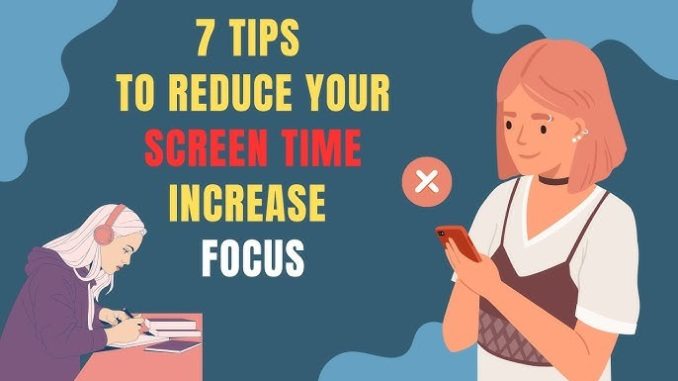
Screens have become the centerpiece of modern life. From the moment we wake up and check our phones to the final scroll before bed, much of our work, entertainment, and social interaction revolves around digital devices. While technology has created incredible opportunities for connection and productivity, the sheer amount of time spent in front of screens has raised concerns about well-being, focus, and even physical health. The challenge for many is not eliminating technology—it is too deeply woven into how we live and work—but finding ways to reduce screen time without disconnecting entirely. With a thoughtful approach, it is possible to strike a healthier balance that preserves the benefits of digital life while avoiding the fatigue and distraction that comes with overuse.
One of the most effective strategies for reducing screen time is to become intentional about how it is spent. Not all screen use is equal, and distinguishing between meaningful engagement and mindless scrolling can make a big difference. For example, an hour spent on video calls with colleagues or researching a project is very different from an hour of aimlessly browsing social media. By identifying which activities add value and which ones simply consume time, it becomes easier to make small adjustments. This awareness can shift screen time from being a passive habit to an active choice, cutting down on unnecessary use without requiring a full retreat from digital life.
Creating natural pauses throughout the day also helps reduce reliance on screens. Many people unconsciously turn to their phones during moments of downtime—waiting for a meeting to start, standing in line, or taking a break from work. Replacing some of these reflexive checks with offline activities, like stretching, walking, or even jotting down notes in a physical notebook, allows the brain to reset while still staying engaged. Over time, these substitutions help weaken the instinct to reach for a device at every idle moment, reducing screen time organically without a sense of deprivation.
Technology itself can also provide solutions. Most smartphones, laptops, and tablets now include built-in tools that track usage and offer reminders when certain limits are reached. These features are not about strict policing but about creating gentle nudges that bring awareness to habits. A notification that you have already spent two hours on social media, for instance, can prompt reflection and encourage you to put the device down. Similarly, activating features such as focus modes or app timers helps create boundaries around the most time-consuming platforms. These adjustments allow people to remain online and productive while preventing overuse from slipping in unnoticed.
Another way to reduce screen exposure without disconnecting is to rethink how information is consumed. Instead of scrolling through news feeds, subscribing to email newsletters or listening to podcasts can deliver updates in a more manageable format. Likewise, replacing some video meetings with audio calls or walking meetings can reduce screen fatigue while still maintaining communication. Even something as simple as printing a document to review on paper, rather than staring at a monitor, can provide relief. These shifts demonstrate that being connected does not always have to mean staring at a glowing screen.
Social interactions are often a significant driver of screen time, but they do not always need to happen through a device. Organizing in-person meetups or phone conversations can maintain connections while cutting down on digital exchanges. When face-to-face meetings are not possible, even blending interactions with movement—such as taking a call while walking outside—can lessen the sense of being tethered to a screen. Finding alternatives to digital interaction does not mean disengaging from people; it means exploring richer and more balanced ways to stay in touch.
Work demands are another area where screen time can spiral out of control, particularly in remote or hybrid environments. Establishing clearer boundaries between work and personal hours helps prevent screens from dominating every waking moment. Closing the laptop at a set time, turning off email notifications in the evening, and designating no-device spaces at home can reinforce these boundaries. This separation does not mean ignoring responsibilities; it means preserving time for offline activities that recharge energy and focus. Ironically, stepping away from screens often improves productivity, since refreshed minds return to digital tasks with sharper attention.
Physical environment also plays a role in managing screen habits. Devices placed within arm’s reach invite constant engagement, while putting them in another room creates natural breaks. Something as simple as leaving the phone on a desk while eating dinner encourages mindfulness and prevents the meal from being consumed alongside endless scrolling. Similarly, using an alarm clock instead of relying on a phone to wake up removes one of the most common triggers for morning screen binges. By adjusting the environment, it becomes easier to reduce screen use without imposing strict self-control.
Perhaps most importantly, reducing screen time is about creating a sense of balance rather than restriction. The goal is not to abandon technology but to use it in ways that enhance rather than dominate daily life. Building in offline rituals—like reading a physical book before bed, spending time outdoors, or pursuing creative hobbies—naturally limits screen exposure while adding richness to life. These moments serve as reminders that meaningful experiences often happen away from devices, and they create a healthier relationship with technology overall.
In the end, reducing screen time without going offline is about being deliberate, not drastic. It is about small adjustments that shift attention away from unnecessary digital habits while preserving the benefits of connection and productivity. By becoming more intentional, leveraging built-in tools, and embracing offline alternatives, it is possible to enjoy the advantages of technology without feeling consumed by it. The result is a life where screens remain useful companions rather than overwhelming masters, allowing for a healthier, more balanced relationship with the digital world.